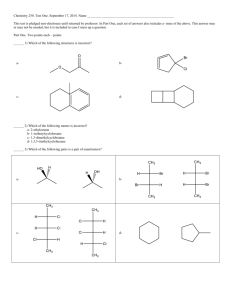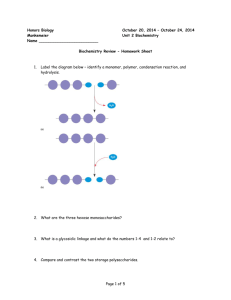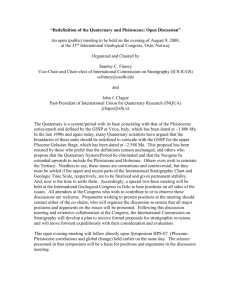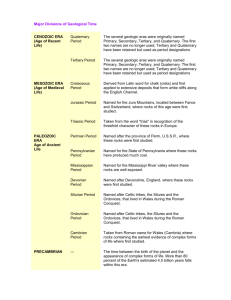Working Papers in Interdisciplinary Economics and Business
advertisement
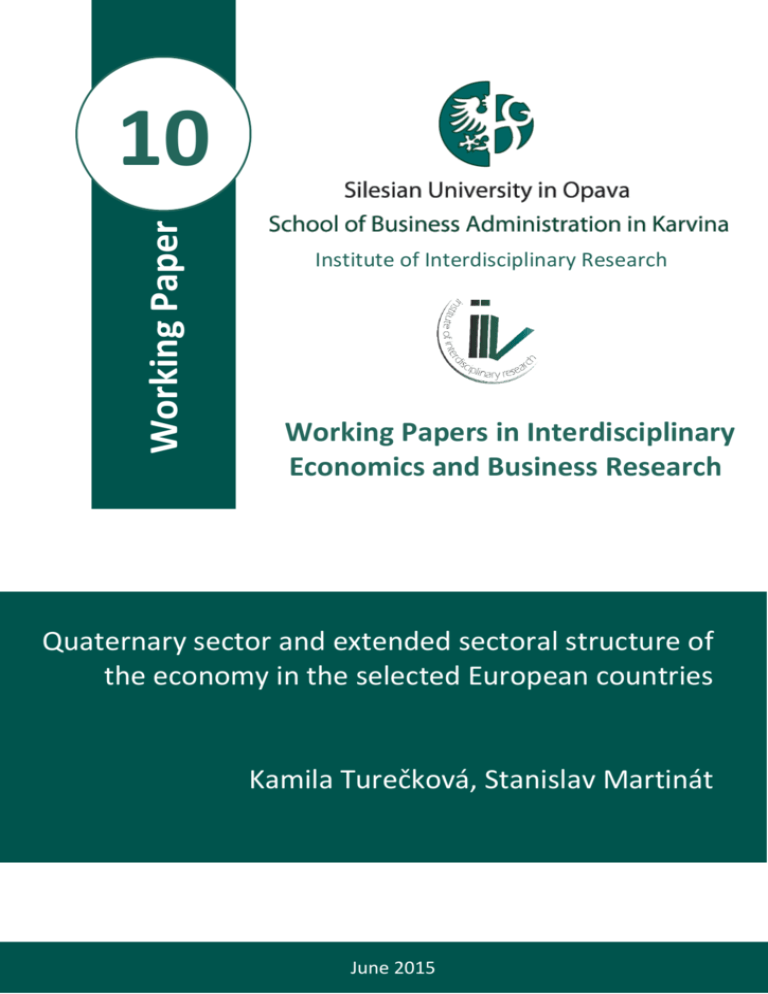
Working Paper 10 Institute of Interdisciplinary Research Working Papers in Interdisciplinary Economics and Business Research Quaternary sector and extended sectoral structure of the economy in the selected European countries Kamila Turečková, Stanislav Martinát June 2015 Working Papers in Interdisciplinary Economics and Business Research Silesian University in Opava School of Business Administration in Karviná Institute of Interdisciplinary Research Univerzitní nám. 1934/3 733 40 Karviná Czech Republic http://www.iivopf.cz/ email: iiv@opf.slu.cz +420 596 398 237 Citation Turečková, K. and S. Martinát, 2015. Quaternary sector and extended sectoral structure of the economy in the selected European countries. Working Paper in Interdisciplinary Economics and Business Research no. 10. Silesian University in Opava, School of Business Administration in Karviná. Abstract Kamila Turečková, Stanislav Martinát: Quaternary sector and extended sectoral structure of the economy in the selected European countries This article deals with definition and establishing of extended sectoral structure of the economy in selected EU countries in years 2003 - 2012. Extended sectoral structure is based on traditional sectoral structure enhanced by fourth, quaternary sector which includes all economic activities touching all areas of intellectual activities and operations. Extended sectoral structure reflects changes and impetuses in the economy and society such as formation of knowledge economy, rising importance of innovation, technology and information and their impact on increase of production potential, competitiveness and economic growth. Key words Extended sectoral structure of the economy, primary sector, secondary sector, tertiary sector, quaternary sector. JEL: N14, P52, R11, R12 Contacts Kamila Turečková, Department of Economics and Public Administration, School of Business Administration, Silesian University, Univerzitní nám. 1934/3, 733 40 Karviná, Czechia, e-mail: tureckova@opf.slu.cz. Stanislav Martinát, Department of Economics and Public Administration, School of Business Administration, Silesian University, Univerzitní nám. 1934/3, 733 40 Karviná, Czechia, e-mail: martinat@opf.slu.cz. Acknowledgement This paper was supported by the project SGS/13/2015 "Influence of Selected Macroeconomic and Microeconomic Determinants on the Competitiveness of Regions and Firms in Countries of the Visegrad Group Plus". The support is gratefully acknowledged. Introduction Every economic system is characterized by a number of different economic activities and operations collected and categorized into specific sectors and into branches of industry and services of the national economy. Agriculture, services and manufacturing are traditionally defined sectors that are usually and generally stable in conventional economic thinking and science. Standard classification of economic activities and operations into primary, secondary and tertiary sector represents practical means for characterization of the structure and the advancement of a country or for simple comparison of the particular countries among themselves or in a course of time. Primary sector is oriented on agriculture, forestry, fishing, mining and quarrying while secondary sector includes economic activities related to fabrication, manufacturing, proceeding of energy and water supply or construction. Tertiary sector contains all provided services (Turečková and Gajdová, 2014). Extended sectoral structure of the economy is closely interconnected with formation of knowledge economy. It is typical for development of sectoral structure that it reflects natural transition from traditional – agricultural – economy through industrial – manufacturing – economy to a modern economy with a dominant share of commerce and services. Now we talk about knowledge (knowledge-based) economy based on generation, development and use of knowledge, ideas, skills and innovational and technological potential. All these issues are intangible assets that allowed increasing productivity, making faster and higher economic growth possible and improve competitiveness across whole spectrum of economic activities. A need to express formation of knowledge-based economy in sectoral structure of the economy and debates about fourth, newly allocated, production factor in form of technology, creates a space and a need to define the fourth economic sector. It was established the quaternary sector that extended the traditional sectoral structure (Turečková, 2014a). The aim of the article is to define the extended sectoral structure theoretically and estimate the extended sectoral structure for selected 25 EU countries in years 2003 - 2012 and also to characterize a tendency and changes in sectoral structure in the analyzed period of time. With use of extended sectoral structure the countries are also compared between each other. This new structure better reflects contemporary changes taking place in the economy where knowledge is the basis of added value and where the formation and use of knowledge have a significant contribution to making the overall welfare of the society. The analysis will be based on empirical data from Eurostat from years 2003 to 2012 and the text of this paper below introduction will be organized as follows: Section 1 is oriented on theoretical approach of traditional and extended sectoral structure and provided review of relevant literature. In Section 2, there is also mentioned methodology and sources of data used to calculate and assemble extended sectoral structure of the economy. Section 3 already take concrete specified extended sectoral structure of particular economies. Finally, the last section, Conclusion, summarizes some major information about extended sectoral structure and its development in EU countries during analyzed period of time. NOTE: Content of this article proceeds from four earlier articles and summarizes the problematics of quaternary sector and extended sectoral structure of the economy solved by authors. 1 1. Review of relevant literature and theoretical approach of sectoral structure in the economy Beginnings of division of the economic sectors can be found in earlier works of mercantilist and for the contemporary economic thinking it was Sir William Petty and Francois Quesnay who described the concrete relations between economy and particular economic sectors, traditionally divided into primary, secondary and tertiary sector (Turečková, 2012). These sectors are made up from economical branches which represent certain part of the national economy which brings together the production of similar or homogenous goods. Branches of economic activity are historically incurred in the process of division of labor. They are distinguished by the character needs that the production of the sector satisfied (Rektořík et al., 2007, p. 17). Economic branches are formed by economic entities with the same or similar orientation in production and relationships between all these branches forming the industrial structure of the national economy (Tetřevová, 2008, p. 23). Sector consists of a set of branches that are characteristically close. There are many different views on the industry-sectoral structure in the context of the classification of individual economic activities that are summarized in the sub-sector (branches). Melišek defines the formation of the sector as a combination of economic sectors with similar characters. According to him (2008, p. 184) "inclusion in a particular sector is carried primarily by the criterion indicator of labor productivity, specifically under objective conditions of labor productivity growth of individual sectors and through the impact of these sectors on the productivity of the national economy." According to the US economist, Allan G. B. Fischer (1936), primary sector groups all work in agriculture and mining, secondary processing sector all work in industry and the tertiary sector is typical for all activities that are dedicated to serving (in the broadest conception). C. Clark divides economic sectors as follows: primary sector includes agriculture, including livestock and logging, secondary sector is industry, which is a permanent transformation of inputs into processed products (including extraction of raw materials), and the tertiary sector, also called service sector, is designed as any other activity, characterized by low labor productivity growth, and not only as a service activity, whose output is not material product, but directly everything what is characterize by utility effect, as well as crafts, repairs and building construction. Different view on these sectors has J. Fourastié whose class actions on three sectors according to the subject they are dealing with, but the criterion is the level of productivity growth: the primary sector is a typical medium-sized technological progress (agriculture), secondary to very intense technological progress (energy, transport, construction, mineral processing) and the tertiary sector is characterized by weak technological progress and it includes public and private services, commerce, banking and insurance or accommodation (in Jelínek et al., 1984, p. 329-330). This theory of three main sectors is quite old and its history dates back to the physiocrats and mercantilists but its modern interpretation is based primarily on the resolution introduced by A. Smith, between productive work, and leading to the production or transformation of products and unproductive work called services. Regardless of differentiating opinions over the definition of the tertiary sector (especially the boundaries between secondary and 2 tertiary) results from the long-time analysis of industrialized countries displays that the service sector compared to agriculture and industry expanded more rapidly. According to Melišek (2008, p. 186) criteria for qualifying sectors are not harmonized. Therefore, the definitions of the sectors use different criteria such as: promoting technological progress, relations in the production process between factors of production, natural conditions, labor productivity, different employment, changes in the composition of demand, the relationship of different activities to satisfy the needs of end, difficulty investment. It could be rightly say that the primary sector includes the economic activities which are inherently basic and primarily closest to humans and which are as old as human history. These activities are the oldest activities which were used to satisfy the essential living and common needs for survival and also were the stimulus for further development of human skills. Among activities included into primary sector belong agriculture and livestock breeding, beekeeping, fruit picking and fishing, hunting and forestry, pasturage, logging, quarrying and mining. The structure and size of the primary sector completely depends on the geo-biological and geological position (location) of particular economy. Rich mineral resources, plentiful soil or the quality of forest are themselves natural presuppositions for the development of this sector and simultaneously give the country a distinct competitive advantage against other states that do not have similar resources conditions (Turečková, 2012). The activities which are included in the secondary sector are directly related to the transformation of raw material and semi-finished products to the finish (end) products. Generally, it is a process of production, processing, montage and construction of the physicalmaterial products. Specifically there are included metalworking and all metallurgical industries, automobile, train, airplane and ships industries, textile, chemical and pharmaceutical industries, mechanical engineering, food industry, building industry, energy and water distribution branch, and many other. The activities of the secondary sector are not dependent on significant resources in the sense that the area disposition of these firms is independent on the place where the resources are naturally located (against the primary sector). It is on individual decisions of business subjects how far from the location of these resources the firms are situated. Factors such as transporting costs, insufficient skilled labor force, labor costs, legal, tax and security situation in the region, the general approach to ecology and environmental protection, the nearness of trade partners or “end” customers play role in this decision-making process (Turečková, 2012). The tertiary sector of the economy includes all economic activities which have unsubstantial form, i.e. services for households, businesses and the state which satisfy the needs of individual and collective. Tertiary sector includes providing services, for example retail, wholesale, transportation, distribution of products, tourism and accommodation, catering, banking and insurance, administration, consulting and legal services, health care, 3 entertainment, media and telecommunication services, education, training, library and others. The nature of the character of the individual services and their enormous variability makes it impossible to establish a common recommendation for their method of delivery. Some service providers are establishing close to their customers and personal contact is very important for them (hairdressers, restaurants, pharmacy services), other services can be delivered globally across countries and continents (computer services, printing services, transportation) (Turečková, 2012). The modern concept of the national economy divided economy into 4-5 sectors (traditional sectoral structure + quaternary and quinary sector), for more information see for example Tetřevová (2008). Authors work with four sector´s structure of the economy and use for it term extended sectoral structure. Extended sectoral structure is a recent issue and it is still not generally used in theoretical and practical level of sectoral research. Therefore it is not necessary and even desirable to divide economic structure into five sectors. A significant increase in the share of the tertiary sector during the 20th century in many countries and growing tendency of assigning increasing relevance and importance to knowledge, technology and innovation for their long-term ability to generate qualitative economic growth, led to extension of the existing (traditional) range of economic sectors by next one - fourth sector. The quaternary sector and its share of total sectoral structure of the economy requires a highly skilled and educated labor and ability of the economies to use effectively their human, social and intellectual capital. “For this reason it is possible to assume its higher representation in highly developed countries and eventually its growing importance over time and to the future. It is an integral property of the output of quaternary sector that, directly or indirectly, intentionally or unintentionally, immediately or with delay but certainly will affect existing sectoral structure and productivity in all spheres of economic activities” (Kenessey, 1987). This quaternary sector was separated from tertiary sector, which included all services and operations, so far. From the tertiary sector allocates into quaternary sector science and public sector services that directly affect the development of a man, i.e. it shall include health care, education, research and science, namely activities in which the future assumes the largest growth rate (Mateides and Ďaďo, 2002, p. 62). According to Kahn it is a common feature of this sector that contributes to the development of a man as an individual to the development of society as a whole. It includes, for example, information technology, banking and insurance (in Jelínek et al., 1984, p. 329). Now a specific group of services which by their nature touches all areas of intellectual and cerebral activities and operations was moved into quaternary sector. That is why quaternary sector is reflection of knowledge-based economy (Turečková, 2014b). It is the knowledgebased economy, transformed in some way to the quaternary sector, which is a significant source of competitive advantage in all areas of the economy and the economy as a whole. “Knowledge-based activities are an important source of national and regional competitiveness. In European Union countries knowledge industries represent not only one of the fastest growing sources of new jobs, but also account for an increasing share of Gross Value Added and exports” (Melachroinos and Spence, 2013). As mention all services related to the generation, application and sharing of knowledge, technology, innovation and information, education, science and research are included in the quaternary sector. This group of complementary services and operations is enhanced by consulting, financial services 4 and activities related to health care and medical research and development. All the rest of services and operations, which are not related to generation and sharing of knowledge and information, remain in tertiary sector. Primary and secondary sector is without changes. The share of quaternary sector on total sectoral structure of the economy requires a highlevel skilled and educated labor and ability of the economies to use their human and intellectual capital effectively and correctly. That is why we can expect the higher share and more dynamic development of quaternary sector in advanced regions and countries in the following period of time. Economic activities and operations included in fourth sector are like an engine of innovations, they create space for emergence of new markets and branches and they are reflected in the original work and management, practices and methods. Therefore the quaternary sector is important for current and future economic growth and qualitative development of the national economy and society at all (Turečková, 2014a). 2. Methodology and data Extended sectoral structure consisting of primary, secondary, tertiary and quaternary sector is determined as a percentage of relevant economic activities to the total value of all economic activities in the country or region, most specifically expressed by gross value added through defined period of time. This analysis is done for regional level NUTS0 (extended sectoral structure is assembled for 25 European countries) and for years 2008 – 2012. It is needed to use a uniform classification of economic activities and its dividing into uniform defined sectors to allow comparison of the sectoral structure between countries or during period of time. The empirical calculation and analysis in this article are mostly based on data from statistical database of Eurostat, concretely from the National Accounts detailed breakdowns, National accounts aggregates and employment by branch (NACE Rev. 2). NACE Rev. 2 (Nomenclature générale des Activités économiques dans les Communautés Européennes) is standard statistical classification of economic activities in the European Community applicable from 1st 2008 is a modified classification from NACE Rev. 1.1, which extends the original classification having regard to new patterns of production and the emergence of new or deeper significance of indigenous economic sectors. NACE Rev. 2. has 21 main sections and 88 divisions. Distribution of the 21 sections (A-U) extended to the sectoral structure, which reflect the extended sectoral structure and the quaternary sector is shown below in Table 1. 5 Tab. 1 - Specification of the economic sectors in the context of the classification of the economic activities according to NACE rev. 2. Economic Economic activities by NACE rev. 2 sector Primary A) agriculture, forestry and fishing B) mining and quarrying Secondary C) manufacturing D) electricity, gas, steam and air conditioning supply E) water supply; sewerage, waste management and remediation activities F) construction Tertiary G) wholesale and retail trade; repair of motor vehicles and motorcycles H) transportation and storage I) accommodation and food service activities L) real estate activities O) public administration and defence; compulsory social security R) arts, entertainment and recreation S) other service activities T) activities of households as employers; undifferentiated goods- and services-producing activities of households for own use U) activities of extra territorial organisations and bodies Quaternary J) information and communication K) financial and insurance activities M) professional, scientific and technical activities N) administrative and support service activities P) education Q) human health and social work activities Source: http://epp.eurostat.ec.europa.eu/ cache/ITY_OFFPUB/KS-RA-07-015/EN/KS-RA07-015-EN.PDF, adjusted by authors It is necessary to properly define the economic activities of group of particular branches of industries, services and operations to be able to assemble extended sectoral structure because there is not one settled circumscription. About primary and secondary sector there are no doubts. We have to set apart all specific economic activities from the conventional traditionally defined tertiary sector which includes all services and convert them into quaternary sector. These activities and industries are, by their nature, practically or theoretically, touching all areas of generation, intensification, development and application of knowledge, technology, innovation, information and so on. All the rest of economic activities persevere in tertiary sector (Turečková, 2014a). The software used was MS Excel. All used calculations and graphical analysis are authors own. 6 3. Extended sectoral structure of the economy in the selected European countries Extended sectoral structure of 25 EU countries presents a good instrument to compare the countries between themselves and also to explain why some of them are more developed than others. Malta, Croatia and Ireland are missing due to lack of data. Figure 1 and figure 2 shows that the countries which are long-term members of EU have larger proportion of services overall, especially of quaternary sector, in its sectoral structure of economy than the countries of Eastern and Central Europe. Fig. 1 - Extended sectoral structure in EU countries in 2003. Source: http://epp.eurostat.ec.europa.eu/portal/page/portal/eurostat/home, adjusted by authors 100% 90% 80% 70% 60% 50% 40% 30% 20% 10% 0% primary secondary tertiary quaternary Fig. 2 - Extended sectoral structure in EU countries in 2012. Source: http://epp.eurostat.ec.europa.eu/portal/page/portal/eurostat/home, adjusted by authors 7 If we compare the average representation of individual sectors in 2003 and 2012 in analyzed EU countries, the representation of primary sector decreased from 4.4% to 3.7% on the secondary sector fell from 27% to 25.7%, the tertiary sector fell from 40.7% to 40.4% while the share of quaternary sector increased from 27.9% to 30.2%. If we focus on comparing the median values between the same time periods, then the value of the primary sector was 3.8 in 2003, while in 2012 3.3 The secondary sector accounted for a median of 27.1 and 25.6, for tertiary 40 and 39.4, and finally median of the quaternary sector was 27.1 for 2003 and 29.1 for 2012. From a sectoral perspective, we can say that the agricultural regions belong to Romania, Bulgaria and Poland, Romania, Czech Republic and Slovakia are the industrialized countries, the traditional services has significantly developed in Greece, Cyprus and Latvia and sector of quaternary services thrives in Luxembourg, in United Kingdom and in the Netherlands (see also table 2). If we compare the share of quaternary sector on all economic activities with per capita GDP in these countries for instance in 2012 the biggest per capita GDP (in PPS) is created by countries such as Luxembourg (263), Netherlands (128), Denmark and Sweden (both 126) while per capita GDP in Czech Republic was 81, in Slovakia 76 and in Poland it was only 67. The result of this comparison is that the countries with more significant level of economic activities oriented towards knowledge, innovation and information achieve a higher degree of economic level. Primary sector was higher than 5,5% (in 2012) of total sectoral structure in Bulgaria (8.8) Romania (6.7), Poland (6.4), Latvia (5.6), Estonia and Netherlands (both 5.5) while the smallest was in Luxembourg (0.4), Belgium (0.8) and surprisingly Germany (1.1). Secondary sector was in range from 12.8% (in Luxembourg) to 41% (in Romania). The highest tertiary sector was in Greece and Cyprus (more than 50%) but if we look at the value of tertiary sector´s economic activities measured in millions of EUR, in Greece it was around 97000 but in Cyprus 8000. For example in United Kingdom tertiary sector embraced economic activities per 588000 millions EUR, France per 766000 and Germany per 870000 while in Czech Republic it was about 50000, Estonia 6000, Slovakia 24000 and Poland 128000, all in millions EUR. Table 2 shows the countries that have the lowest and also the largest share of each sector. From this point of view we can say that the most clear-cut country in terms of sectoral breakdown is Luxembourg. Luxembourg had the lowest share of primary and also secondary sector from all analyzed countries during analyzed period of time and was a “leader” in quaternary sector. The tertiary sector was the most abundant of all sectors in Greece. On the opposite of this country in sectoral structure was Romania. The rest of EU countries had ambivalent industry - sectoral structure. This could be positive because of the benefits of differentiation. On the other hand, Luxembourg as a specialist on services included in quaternary sector could have a competitive advantage because of concentration of these services in the same area (through positive externalities). 8 Tab. 2 - Specification of the economic sectors in the context of the classification of the economic activities according to NACE rev. 2. the lowest share of the whole sector Year/Sector Primary Secondary Tertiary Quaternary 2003 Luxembourg Luxembourg Luxembourg Romania 2004 Luxembourg Luxembourg Romania Romania 2005 Luxembourg Luxembourg Luxembourg Romania 2006 Luxembourg Luxembourg Luxembourg Romania 2007 Luxembourg Luxembourg Luxembourg Romania 2008 Luxembourg Luxembourg Luxembourg Romania 2009 Luxembourg Luxembourg Luxembourg Romania 2010 Luxembourg Luxembourg Romania Romania 2011 Luxembourg Luxembourg Romania Lithuania 2012 Luxembourg Luxembourg Romania Lithuania the largest share of the sector on the whole 2003 Romania Czech Republic Greece Luxembourg 2004 Romania Czech Republic Greece Luxembourg 2005 Romania Czech Republic Greece Luxembourg 2006 Romania Slovakia Greece Luxembourg 2007 Romania Slovakia Greece Luxembourg 2008 Bulagaria Slovakia Greece Luxembourg 2009 Romania Romania Greece Luxembourg 2010 Romania Romania Greece Luxembourg 2011 Romania Romania Greece Luxembourg 2012 Bulagaria Romania Greece Luxembourg Source: http://epp.eurostat.ec.europa.eu/portal/page/portal/eurostat/home, adjusted by authors 8,00 6,00 4,00 2,00 0,00 -2,00 -4,00 -6,00 -8,00 primary secondary tertiary quaternary Fig. 3 – Changes in sectoral structure in EU countries during years 2003 - 2012. Source: http://epp.eurostat.ec.europa.eu/portal/page/portal/eurostat/home, adjusted by authors 9 Changes in sectoral structure (in %) in EU countries between years 2003 and 2012 is shown in figure 3. We can see there that in most of countries the trend was caused by changes in favour of quaternary sector at the expense of secondary sector. The average amount of quaternary sector for the analyzed group of countries in 2003 was 27.9% while in 2012 it was 30.2%. This means that its importance grew approximately by 8.3% over ten years. For primary sector it was 4.4% in 2003 while in 2012 it was 3.7%, for secondary sector it was 27% in 2003 while in 2012 it was 25.7% and for tertiary sector it was 40.7% in 2003 while in 2012 it was 40.4%. Conclusion The requirement to extend traditional three sectors by a next one – quaternary sector – and use of extended sectoral structure instead of conventional sectoral structure is needful to reflect contemporary development and trend of the formation of a knowledge-based economy and to express the relevant and significant changes in particular economic activities and operations. Innovation, technology, information, research, education and science are key and determining factors for economic growth in the future in all economies and it can be simply declared and analyzed by extended sectoral structure and instituted quaternary sector. Generally, knowledge of industry structure or individual sectors allows examining their interdependence with a wide variety of economic and social variables such as the level of knowledge, competitiveness of the economy, the structure of investment, degree of science and research etc. The aim of this paper was definition and determination of extended sectoral structure and quaternary sector EU countries and analysis of its development. The result of the analysis clearly confirmed the trend to have bigger share of quaternary sector in highly development countries and common trend to significant growth of economic activities and operations included in quaternary sector instead of all other branches of industries, commerce and services. References [1] Eurostat, 2014. NACE Rev. 2. [online]. [2014-03-01]. Available from: http://epp. eurostat.ec.europa.eu/cache/ITY_OFFPUB/KS-RA-07-015/EN/KS-RA-07-015-EN.PDF. [2] Eurostat, 2014. Statistics. [online]. [2014-02-15]. Available from: http://epp.eurostat. ec.europa.eu/portal/page/portal/statistics/themes [3] Fischer, Allan G. B., 1939. Production, Primary, Secondary and Tertiary. Economic Record, 15(1). [4] Jelínek, J. et al., 1984. Ekonomická encyklopedie 2 (P-Z). 2. Přepracované vydaní. Praha: Svoboda. [5] Kenessey, Z., 1987. The Primary, Secondary, Tertiary and Quaternary Sectors of the Economy [online]. [cit.2012-09-28]. Available: http://www.roiw.org/ 1987/359.pdf [6] Mateides, A. a J. Ďaďo, 2002. Služby. Bratislava: Ing. Miroslav Mračko. 10 [7] Melachroinos, K. A. and N. Spence, 2013. The territorial impact of the knowledge economy: intangibles and regional inequality in Great Britain. European Planning Studies, vol. 21, issue 10, pp. 1491-1508. [8] Melišek, F., 2008. Ekonomický rast a štrukturne zmeny. Bratislava: Sprint dva. [9] Rektořík, J. et al., 2007. Ekonomika a řízení odvětví veřejného sektoru. Praha: Ekopress. [10] Tetřevová, L., 2008. Veřejná ekonomie. Opava: Optys. [11] Turečková, K. and K. Gajdová, 2014. Extended sectoral structure and analysis of selected branches of the economy in the Czech Republic and Slovak Republic. In: Proceedings of the International Workshop Ten years of Membership of the Czech and Slovak Republic in the European Union. Karviná: OPF SU Karviná, pp. 226-239. [12] Turečková, K., 2012. Vymezení sektorové struktury hospodářství v kontextu formování znalostní ekonomiky. In Sborník příspěvků V. Mezinárodní vědecké konference doktorandů a mladých vědeckých pracovníků. Karviná: Silesian University, School of Business Administration, pp. 651-657. [13] Turečková, K., 2014a. Extended sectoral structure of the economy in Czech Republic and EU countries. In: 10th International Bata Conference for Ph.D. Students and Young Researchers 2014. Zlín: UTB Zlín. [14] Turečková, K., 2014b. Quaternary sector as a source of growth and competitiveness in the EU. In: Proceedings of the 2nd International Conference on European Integration 2014. Ostrava: VŠB-TU Ostrava, pp. 723-730. 11 Appendix - Data sources Table A.1: Share of primary sector in European countries (25) on total sectoral structure between years 2003 - 2012 (in %) GEO/TIME Belgium Bulgaria Czech Republic Denmark Germany Estonia Greece Spain France Italy Cyprus Latvia Lithuania Luxembourg Hungary Netherlands Austria Poland Portugal Romania Slovenia Slovakia Finland Sweden United Kingdom 2003 2004 2005 2006 2007 2008 2009 2010 2011 2012 1,2 1,2 0,9 1,0 0,9 0,8 0,8 0,9 0,7 0,8 12,0 11,8 10,5 9,6 7,9 9,3 6,9 7,5 7,9 8,8 3,8 4,0 3,8 3,8 3,7 3,8 3,2 2,9 3,7 3,5 4,4 4,7 5,2 5,3 5,0 5,1 3,7 4,6 5,3 5,0 1,1 1,3 1,0 1,1 1,1 1,3 1,0 1,0 1,0 1,1 5,0 4,9 4,4 4,1 4,6 3,8 3,7 4,7 5,3 5,5 6,0 5,4 5,4 4,1 3,9 3,5 3,4 3,5 3,7 4,2 4,2 3,8 3,4 3,0 3,1 2,8 2,6 2,8 2,7 2,7 2,3 2,2 2,1 1,9 2,0 1,9 1,7 2,0 2,1 2,1 3,0 2,9 2,6 2,5 2,4 2,4 2,2 2,2 2,4 2,4 3,6 3,4 3,2 2,8 2,6 2,7 2,7 2,7 2,8 2,7 4,3 4,6 4,2 3,8 3,9 3,3 4,3 5,6 5,7 5,6 5,5 5,1 5,3 4,7 4,3 4,1 3,1 3,6 4,2 4,4 0,7 0,7 0,6 0,5 0,5 0,5 0,4 0,4 0,4 0,4 4,8 5,3 4,6 4,4 4,4 4,3 3,8 3,8 4,9 5,0 4,6 4,6 4,7 5,4 5,0 5,8 4,6 4,9 5,1 5,5 2,1 2,2 1,9 2,0 2,1 2,1 1,8 2,0 2,2 2,1 6,5 7,6 7,1 6,7 6,6 6,1 5,8 6,2 6,8 6,4 3,5 3,5 3,2 3,3 2,9 2,8 2,7 2,7 2,6 3,0 14,6 15,5 11,0 10,4 8,0 8,6 8,5 8,3 8,9 6,7 3,0 3,2 3,2 2,8 3,0 2,8 2,8 2,9 3,2 3,1 5,1 4,6 4,2 4,0 4,6 4,8 4,0 3,4 4,0 3,6 3,3 3,1 3,0 2,8 3,4 3,1 3,2 3,3 3,3 3,3 2,2 2,2 1,7 2,1 2,3 2,5 2,0 2,7 2,6 2,4 3,0 3,0 3,0 3,2 3,0 3,4 2,6 3,0 3,0 3,0 Source: http://epp.eurostat.ec.europa.eu/portal/page/portal/eurostat/home, adjusted by authors 12 Table A.2: Share of secondary sector in European countries (25) on total sectoral structure between years 2003 - 2012 (in %) GEO/TIME Belgium Bulgaria Czech Republic Denmark Germany Estonia Greece Spain France Italy Cyprus Latvia Lithuania Luxembourg Hungary Netherlands Austria Poland Portugal Romania Slovenia Slovakia Finland Sweden United Kingdom 2003 24,8 26,5 34,8 22,4 28,8 27,8 18,7 30,7 21,3 26,1 21,8 23,6 30,6 18,6 30,4 21,4 29,9 27,6 26,2 33,0 34,0 34,3 32,2 27,1 22,2 2004 24,7 25,8 36,7 21,8 29,1 27,5 18,6 30,8 21,1 26,2 22,0 23,7 32,0 18,3 31,1 21,2 29,8 28,4 25,8 33,4 33,8 35,9 31,8 27,4 21,5 2005 24,2 27,2 36,7 21,6 29,1 28,7 19,2 31,5 20,8 26,1 21,8 22,8 32,2 17,3 31,3 21,4 29,7 28,3 25,0 34,4 33,2 35,8 31,8 27,4 21,2 2006 24,3 28,4 36,9 22,0 29,9 29,8 21,4 31,6 20,6 26,4 21,9 23,4 32,6 16,0 31,0 21,2 29,7 29,0 24,8 35,1 33,6 38,5 32,9 27,4 21,1 2007 24,1 30,1 37,2 21,7 30,3 30,0 20,1 30,9 20,4 26,8 22,5 24,9 32,7 17,1 30,9 21,6 30,2 29,5 24,8 36,6 34,2 37,9 33,1 27,5 20,6 2008 23,6 29,0 36,5 21,3 29,8 29,0 18,8 30,2 20,0 26,3 22,1 24,8 32,2 15,7 30,2 21,3 29,4 29,3 24,2 36,9 33,3 38,2 31,6 26,0 19,9 2009 22,2 29,3 35,9 19,5 27,6 25,9 17,0 28,2 19,3 24,7 19,5 23,2 27,7 13,5 29,4 21,1 28,3 30,5 22,9 37,1 30,4 33,8 27,2 24,2 19,3 2010 22,4 26,8 35,7 18,6 30,0 27,0 16,7 27,0 18,8 24,7 18,0 23,3 29,0 13,1 30,3 20,8 28,2 29,7 23,5 40,2 29,5 35,2 27,7 25,9 19,2 Source: http://epp.eurostat.ec.europa.eu/portal/page/portal/eurostat/home, adjusted by authors 13 2011 22,2 28,0 35,9 18,4 30,5 27,8 15,5 26,4 18,7 24,5 16,1 24,1 30,8 12,8 30,0 21,0 28,2 30,3 23,6 40,7 30,0 35,6 26,6 25,1 19,2 2012 21,7 28,0 36,1 18,2 30,3 27,6 18,4 25,7 18,7 23,9 14,7 25,1 30,6 12,8 30,3 20,5 28,0 30,0 24,5 41,0 30,6 34,7 25,6 24,4 20,5 Table A.3: Share of tertiary sector in European countries (25) on total sectoral structure between years 2003 - 2012 (in %) GEO/TIME Belgium Bulgaria Czech Republic Denmark Germany Estonia Greece Spain France Italy Cyprus Latvia Lithuania Luxembourg Hungary Netherlands Austria Poland Portugal Romania Slovenia Slovakia Finland Sweden United Kingdom 2003 39,2 41,8 38,5 40,1 38,7 44,6 53,2 39,1 41,9 42,6 48,3 49,0 44,6 35,0 37,5 37,3 40,0 41,7 42,1 35,9 35,9 40,1 37,4 36,5 36,8 2004 38,9 41,8 37,0 40,2 38,1 44,4 53,6 39,5 42,1 43,0 48,3 49,9 44,2 34,6 36,8 37,3 40,3 40,1 42,1 34,1 35,7 39,4 37,4 35,8 36,8 2005 39,5 40,5 36,8 39,9 38,5 43,6 51,0 39,2 42,3 42,9 48,4 50,2 44,0 33,4 36,7 36,8 40,3 40,9 42,5 37,7 36,3 39,4 37,6 36,1 36,6 2006 39,4 41,8 36,9 39,5 38,1 42,9 49,6 39,3 42,3 43,0 48,6 49,7 43,5 31,4 37,3 36,8 40,1 40,7 42,2 37,5 36,1 37,5 36,6 36,2 35,9 2007 39,5 39,2 36,1 40,0 38,1 42,0 51,7 39,1 42,4 42,6 48,0 48,4 42,8 31,2 38,3 37,2 39,5 39,6 42,4 38,0 35,8 37,1 35,6 35,9 35,8 2008 39,6 38,6 35,6 39,1 38,4 41,9 52,5 39,4 42,9 42,9 47,8 46,9 43,4 33,1 38,9 36,6 39,7 39,7 42,5 36,5 36,7 36,6 36,7 36,6 35,8 2009 39,2 38,8 35,8 39,3 39,5 42,7 52,9 40,0 43,0 44,2 49,2 48,3 46,5 33,8 38,9 35,0 41,0 40,1 43,8 36,2 38,0 39,1 38,6 37,3 35,5 2010 38,7 39,6 36,4 40,5 37,4 41,9 53,8 42,1 42,8 44,0 49,5 48,6 46,4 33,8 38,6 34,8 41,0 40,2 43,7 32,5 37,7 38,9 38,2 35,8 36,6 Source: http://epp.eurostat.ec.europa.eu/portal/page/portal/eurostat/home, adjusted by authors 14 2011 38,6 38,0 35,1 40,1 37,3 42,2 55,7 42,9 42,7 44,4 49,8 48,3 45,3 35,4 38,4 35,0 40,7 39,3 44,2 30,3 37,4 38,2 38,9 36,2 37,3 2012 38,7 37,0 35,4 40,2 37,3 43,0 52,7 43,8 42,6 45,1 50,1 48,1 46,2 35,1 37,7 34,3 40,7 40,1 42,9 30,9 37,1 38,9 39,3 36,1 36,3 Table A.4: Share of quaternary sector in European countries (25) on total sectoral structure between years 2003 - 2012 (in %) GEO/TIME Belgium Bulgaria Czech Republic Denmark Germany Estonia Greece Spain France Italy Cyprus Latvia Lithuania Luxembourg Hungary Netherlands Austria Poland Portugal Romania Slovenia Slovakia Finland Sweden United Kingdom 2003 34,8 19,7 22,8 33,1 31,4 22,6 22,1 26,0 34,6 28,4 26,2 23,0 19,3 45,7 27,3 36,7 28,0 24,2 28,1 16,5 27,2 20,5 27,0 34,2 38,1 2004 35,2 20,6 22,3 33,3 31,5 23,2 22,3 25,8 34,6 28,0 26,3 21,8 18,6 46,4 26,8 36,9 27,7 23,9 28,6 16,9 27,3 20,1 27,7 34,6 38,7 2005 35,3 21,8 22,6 33,3 31,4 23,3 24,4 25,9 34,7 28,4 26,5 22,9 18,5 48,8 27,4 37,2 28,1 23,7 29,2 16,9 27,3 20,6 27,5 34,8 39,2 2006 35,3 20,2 22,4 33,2 30,9 23,2 24,9 26,1 35,2 28,1 26,7 23,1 19,1 52,1 27,4 36,5 28,2 23,7 29,7 17,0 27,6 20,0 27,8 34,3 39,9 2007 35,4 22,8 23,0 33,3 30,6 23,5 24,3 26,9 35,2 28,1 27,0 22,8 20,2 51,3 26,4 36,2 28,2 24,3 29,9 17,3 27,0 20,3 27,9 34,3 40,5 2008 36,1 23,1 24,1 34,4 30,5 25,3 25,2 27,6 35,1 28,3 27,4 25,0 20,3 50,8 26,6 36,4 28,8 24,9 30,5 18,0 27,3 20,5 28,6 35,0 40,9 2009 37,8 25,0 25,0 37,5 32,0 27,7 26,6 29,1 36,0 28,9 28,5 24,2 22,7 52,3 28,0 39,3 28,9 23,7 30,6 18,2 28,8 23,1 31,0 36,5 42,7 2010 38,0 26,0 24,9 36,4 31,5 26,5 26,0 28,1 36,5 29,1 29,8 22,6 21,0 52,8 27,3 39,6 28,8 23,9 30,1 19,0 29,9 22,5 30,8 35,6 41,2 Source: http://epp.eurostat.ec.europa.eu/portal/page/portal/eurostat/home, adjusted by authors 15 2011 38,4 26,0 25,3 36,2 31,2 24,7 25,1 28,0 36,5 28,8 31,3 21,9 19,7 51,4 26,7 38,9 29,0 23,7 29,6 20,1 29,4 22,3 31,2 36,0 40,5 2012 38,8 26,2 24,9 36,6 31,3 23,9 24,7 27,8 36,6 28,7 32,5 21,2 18,8 51,7 27,0 39,7 29,1 23,6 29,6 21,4 29,1 22,7 31,8 37,1 40,2
